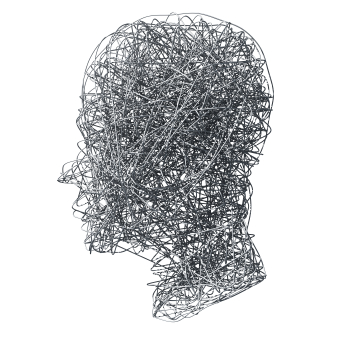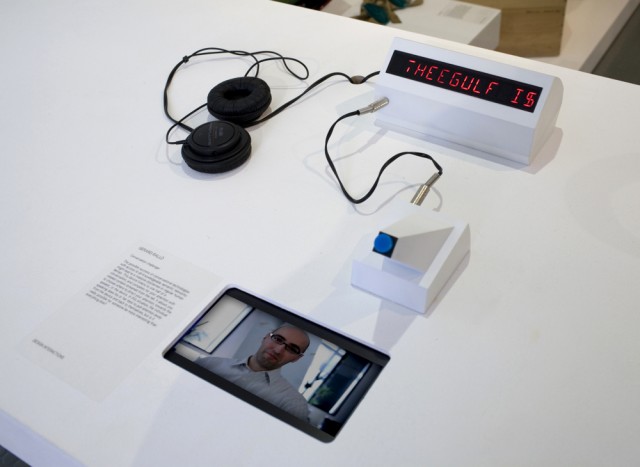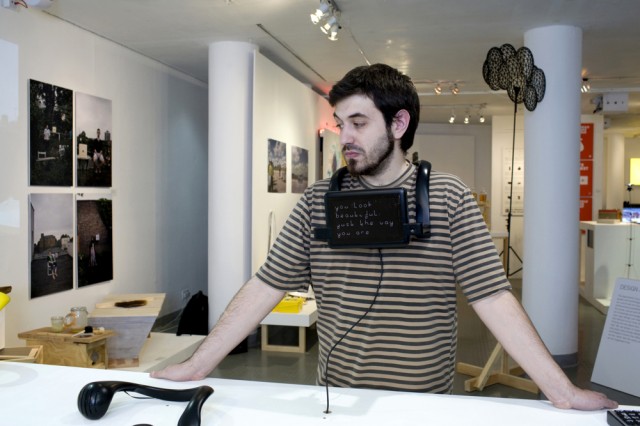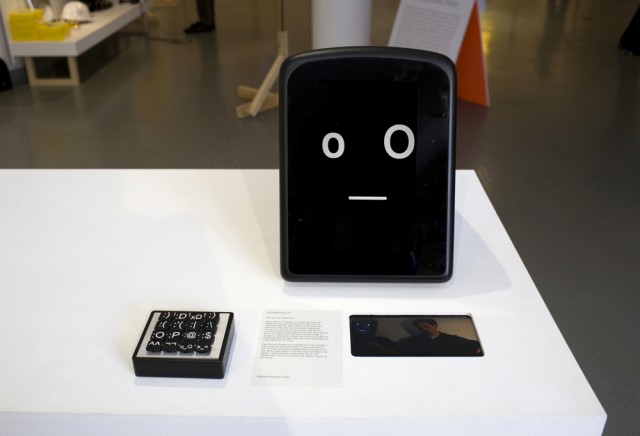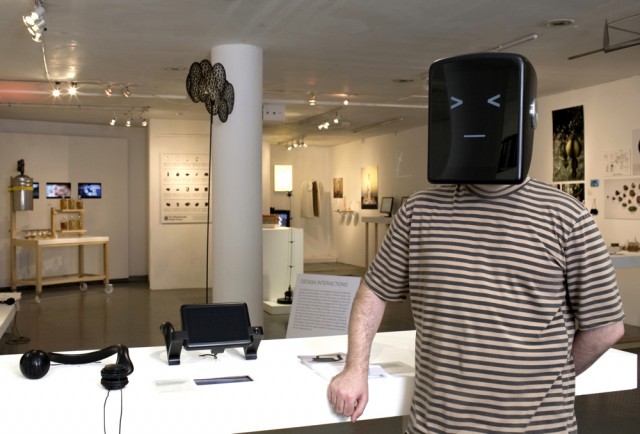- Computers That See You and Keep Watch Over You
High-resolution, low-cost cameras are proliferating, found in products like smartphones and laptop computers. The cost of storing images is dropping, and new software algorithms for mining, matching and scrutinizing the flood of visual data are progressing swiftly.
People will increasingly be surrounded by machines that can not only see but also reason about what they are seeing, in their own limited way.
The challenge arises from the prospect of the rapid spread of less-expensive yet powerful computer-vision technologies.
At work or school, the technology opens the door to a computerized supervisor that is always watching. Are you paying attention, goofing off or daydreaming? In stores and shopping malls, smart surveillance could bring behavioral tracking into the physical world.
More subtle could be the effect of a person knowing that he is being watched — and how that awareness changes his thinking and actions. It could be beneficial: a person thinks twice and a crime goes uncommitted. But might it also lead to a society that is less spontaneous, less creative, less innovative?
Reblogs for 20110103
- Transcending the Human, DIY Style
Anonym, a biohacker, has spent the last several years doing “DIY transhumanism,” learning how to extend her own senses.
“The existing transhumanist movement is lame. It’s nano everything. It’s just ideas,” she says.
She inserted small metal discs of neodymium metal, coated in gold and silicon, which give off mild electric current when in a electromagnetic field. When inserted under the fingertips, this current stimulates the fingers’ nerve endings, allowing the bearer to literally feel the shape and strength of electromagnetic fields around power cords or electronic devices.
Her next project: a small compass chip with a power coil that can be charged externally, and output in the form of neural-grade electrodes, all to be implanted near her left knee.
She’s put herself in the hospital several times.
Reblogs for 20110102
- Debtris
Our first animation. Enjoy!
$US version – see the video on youtube
£UK version – see the video on youtube
Data: http://bit.ly/debtris
We’ve been honing our animation skills. Expect more films, motion infographics and ‘info-mations’ in 2011. Follow us on Youtube for more.
Design & direction: David McCandless
Animation: Miles Tudor, Dom Del Torto @ Big Animal
Music: Daniel Pemberton
Data: http://bit.ly/debtris
Reblogs for 20101231
- Technology 25 Years Hence
“The law of accelerating returns is the only reliable method I know that allows us to forecast at least certain aspects of the future,” said Ray Kurzweil in “Why Do We Need Predictions?,” a New York Times special feature published Monday.
“A computer that fit inside a building when I was a student now fits in my pocket, and is a thousand times more powerful despite being a million times less expensive. In another quarter century, that capability will fit inside a red blood cell and will again be a billion times more powerful per dollar.”
- What is Traitorware?
Your digital camera may embed metadata into photographs with the camera’s serial number or your location. Your printer may be incorporating a secret code on every page it prints which could be used to identify the printer and potentially the person who used it. If Apple puts a particularly creepy patent it has recently applied for into use, you can look forward to a day when your iPhone may record your voice, take a picture of your location, record your heartbeat, and send that information back to the mothership.
This is traitorware: devices that act behind your back to betray your privacy, says EFF.
Transcending the Human, DIY Style
Anonym, a biohacker, has spent the last several years doing “DIY transhumanism,” learning how to extend her own senses.
“The existing transhumanist movement is lame. It’s nano everything. It’s just ideas,” she says.
She inserted small metal discs of neodymium metal, coated in gold and silicon, which give off mild electric current when in a electromagnetic field. When inserted under the fingertips, this current stimulates the fingers’ nerve endings, allowing the bearer to literally feel the shape and strength of electromagnetic fields around power cords or electronic devices.
Her next project: a small compass chip with a power coil that can be charged externally, and output in the form of neural-grade electrodes, all to be implanted near her left knee.
She’s put herself in the hospital several times.
Reblogs for 20101224
- US to offer plethora of prize competitions to solve tough problems
The America Competes Act, renewed by Congress this week, now gives every federal department and agency the authority to conduct prize competitions.
According to the Office of Science and Technology Policy blog: “Whether it’s developing new products that will be manufactured in America, or getting and using energy more sustainably, or improving health care with better therapies and better use of information technology, or providing better protection for our troops abroad and our citizens at home, innovation will be key to our success.”
The prize competition idea follows on some very successful challenge programs offered by the X Prize Foundation and the government’s own Defense Advanced Research Projects Agency and Challenge.gov site.
- Man Cured of HIV Using Stem Cells. Fluke or Hope?
Timothy Ray Brown has officially been declared cured of HIV. A US citizen living in Germany with HIV, Brown was treated for leukemia in 2007 at the Charite University of Medicine in Berlin. As part of his treatment, he received stem cell transplants from a donor with a naturally occurring genetic resistance to HIV. In February of 2009, his doctors published a report in the New England Journal of Medicine detailing the apparent absence of the HIV virus in his system after being treated for leukemia. Now, in the medical journal Blood, those doctors have described the even more rigorous examination of his body, including looking at brain and spinal samples, that they performed to demonstrate that Brown no longer has HIV. The virus isn’t simply in regression, it’s gone. While the exact methods used to remove HIV from Brown will likely prove too severe to see use in other patients, his cure raises the possibility of new avenues of attack against the disease. Should this case raise our hopes about a universal cure for HIV/AIDS? Yes, but with some big caveats.
Brown’s path to a cure was not for the faint of heart. I discussed part of his case history in my coverage of his condition in the beginning of this year, but it’s remarkable enough to bear repeating. Having contracted HIV in the ’90s, Brown was being successfully treated using anti-retroviral drugs (HAART) but developed acute myeloid leukemia in 2006. To treat the cancer, Brown was subjected to three rounds of chemotherapy, drastically impairing his immune system. It also induced renal failure, and so his HAART treatments had to end. Predictably, the levels of HIV in his system spiked. After three months he was able to resume standard HIV therapy and his levels dropped again. That’s when the cancer returned stronger than ever. With his infected immune system nearly destroyed, he was ready to have it augmented by someone else’s. Brown received bone marrow stem cell transplants from a donor, a process that carried a significant risk of death (about one in three don’t survive) but that would allow the donor’s immune system cells to grow inside him. A year after this dangerous procedure he had to go through it again. Despite all these opportunities for disaster, Brown survived.
More than that, his HIV was gone. Brown’s stem cell donor had been selected because he possessed a genetic variation that causes a receptor (CCR5) to be missing from his cells. This variation occurs in around 1% of people of Caucasian descent and has been known to confer a strong resistance to select strains of HIV by interfering with the way the virus enters human cells. It’s thought that the damage to his immune system, followed by the stem cell transplant, caused all traces of HIV to be removed from Brown’s body. Chemo killed off infected cells and the new resistant cells kept the virus from rebounding.
All this came at a price, however. Brown has been on immuno-suppressive drugs for 38 months. Following his transplant (17 months) he developed a neurological condition that required a brain biopsy and sampling of cerebrospinal fluid. According to AIDSMap, that neurological condition led to injury including temporary blindness, and Brown is still undergoing physiological and speech therapy to help him recover.
During his long recovery, doctors continually took samples of his immune system, measured the level of HIV antibodies, and examined the biopsied brain sample. Every indicator showed that Brown’s immune system was not only being populated by the donor cells, but that the viral load in his body was apparently zero. In Blood, the doctors at Charite University of Medicine point out that the donor cells are still susceptible to certain strains of HIV. In fact, Brown had those strains! Despite this remaining susceptibility, the virus never rebounded. It looks to have been completely cleared. As I said when discussing Brown earlier this year, the complete removal of HIV with stem cells containing a genetic variant that shouldn’t have provided him universal protection is very curious. It shows that there is still much to learn about genetic resistance to the virus.
Brown’s own clinical history has proven harsh, but his ongoing legacy is going to provide some remarkable hope to HIV patients everywhere. Will we subject patients to multiple rounds of chemotherapy followed by stem cell transplants from special donors with faulty CCR5 receptors? I certainly hope not, especially considering how effective HAART can be when managing HIV/AIDS. Repeating Brown’s ordeal would be unnecessarily risky for patients. One in three would likely die! Yet there are parts of his treatment that could be pursued. According to AIDSMap, doctors have explored the possibility of collecting large stores of stem cells from donors with the right kind of CCR5-based resistance. Researchers are also performing clinical trials to study ways in which the CCR5 receptor could be knocked out of cells using gene therapy. Why receive a transplant when you can just teach your cells to bar their doors against HIV?
Genetic therapies may prove to be a possible cure for HIV/AIDS. There are, in fact, multiple targets for such treatments. We recently discussed how variations in the HLA-B protein and gene can also provide protection against the disease. It will take several years to understand and perfect such roadblocks that we can use to stop the spread of HIV in the body. While gene therapies are promising avenues of research, and are reinforced in theory by Brown’s case history, such cures won’t be around for a while.
That long-term hope without short-term payoff is how I would characterize this case in general. The power of the CCR5 variation and its ability to be transferred to others through stem cell transplant is remarkable. Yet while we may see Brown’s treatment repeated, it is simply not a practical therapy for most HIV patients. Eventually, however, we’ll have enough genetic targets, and enough experience hitting them, that we’ll be able to “upgrade” the immune systems of the HIV infected with minimal risk to their lives. With any luck, such treatments will be cheap enough that they can be provided to people all over the world. Who knows, maybe we’ll even find a way to provide such ‘natural’ resistance as a preventative measure. Brown’s heroic journey through chemotherapy and stem cell transplants, his defeat of cancer and HIV, and his living proof that a cure is possible, make for a momentous occasion. It should give us hope, but it will also demand patience.
[image credit: Peter Rigaud]
[sources: Hutter et al 2009, NEJM; Allers et al 2010, Blood; AIDSMap]Related Posts:
Reblogs for 20101222
- Visualizing Bloodtests
We were happy to win a design competition in Wired US this month.
It was around re-envisioning medical data. Specifically, blood test results. Which suck, design-wise. They still look like secret missives from the CIA circa 1965. Yet their contents are vitally – perhaps mortally – important.
Our challenge was to approach a cholesterol level test. First it looked like this.

Then we designed it thus:
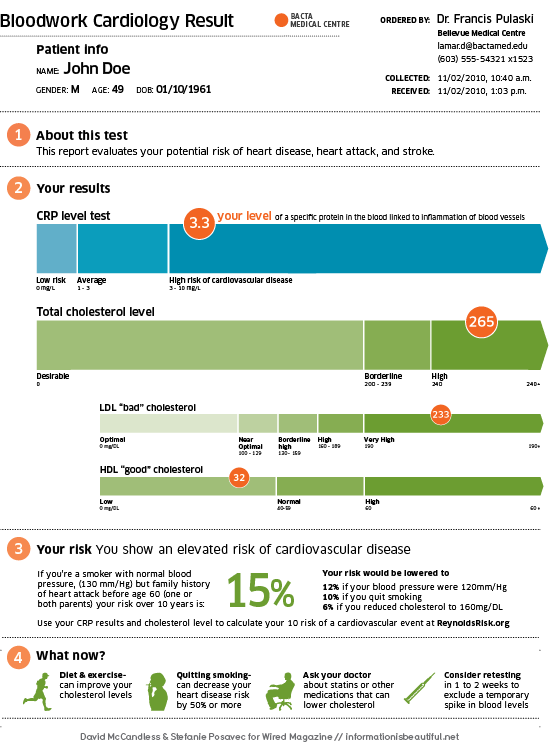
Our goal wasn’t just a polish job. We worked hard on the information too. So there was context for all the facts and figures. Ideally, anyone, of any educational background, could get the gist and plan their next move.See a hi-res version here. Or download a PDF.
(The image is creative commons. All non-commercial use is cool.)
Great work too from Mucca Design and Jung Und Wenig
DESIGN & RESEARCH: David McCandless & Stefanie Posavec
ADDITIONAL DESIGN: Stefanie Posavec, Joe Swainson
CREATIVE DIRECTOR: Tim Leong @ Wired
Reblogs for 20101216
- Neuro Nonsense
In her new book “Delusions of Gender: How Our Minds, Society, and Neurosexism Create Difference,” Cordelia Fine takes a critical look at the evidence that the brains of men and women are wired differently, says Ben A. Barres, Department of Neurobiology, Stanford University School of Medicine.
“The main theme of the book is that current widespread beliefs about gender—that is, we needn’t worry about social or cultural factors leading to sex inequality because hardwired differences between the sexes are to blame—just don’t bear up to scrutiny….
“Fine points out how much writing about sex differences consists of just-so stories that can be easily constructed because the relationship between brain structure and cognitive function is still poorly understood. Such just-so stories are also the bread and butter of a field known as evolutionary psychology. Darwin, Pinker, and others have long argued that men have evolved different neural circuits that imbue them with different (superior) cognitive abilities that favor more competitive and risk-taking behaviors.
“But the field of evolutionary psychology has been the subject of many recent critiques. Not only are its hypotheses untestable and unfalsifiable, they also involve circular reasoning; the thinking starts out with sexist Darwinian biases, like males are more competitive, and then ends at the same starting point, concluding that male neural circuits have evolved for competition.”
PLoS articles are open access. – Ed
- Google: We’ll find info before you know you need it
Google is working on a service using “contextual discovery” for pushing information out to people before they’ve started to look for it, based on factors such as their web browsing history or current location.
Reblogs for 20101215
- Brain Oddities: Spelling is Irrelevant to Comprehension
In trying to make sense of the world around us, our brains have evolved to do some very odd things. The more we learn about our cognitive processes, the more it seems we have inherited a very weird wetware set, filled with bizarre and misleading foibles.
While most of the cognitive errors I reference here work against us — especially as investors — today’s example of a cognitive process works strangely in the brain’s favor: Spelling don’t matter. Comprehension remains essentially unchanged, even when all letters of a word are totally mixed up — just so long as the first and last letters are in their proper place.
Spelling, it seems, is irrelevant to comprehension. Try this jumble below and see if the flawed wetware you call a brain can read it:
>
>
Pretty cool, eh? Quite a marvelous set of neurons you got there . . .
- Devices For Mindless Communication [Objects]
Devices For Mindless Communication is a collection of projects by Gerard Rallo, a researcher, technologist, designer and a recent graduate of MA in Design Interactions from the Royal College of Art. His work explores speculative roles of technology to interrogate social implications of progress.
With new technologies as an important driver, certain real life interactions are falling into disuse for large segments of society.
As a result, we see a mix of social groups with radically different values, social skills, perceptions, and ways of engaging the real world and its inhabitants. With this set up, these projects explore how we interact with each other, and speculate about alternative roles of technology, those mediating the most mundane communication practices in shared physical spaces. Practice, based on near future projections of current behavioral and technological trends, as an exercise of reflection on how bizarre our fundamental communication practices and basic assumptions might be seen when looked at from another perspective.Gerard Rallo, together with Andrew Frien, Sitraka Rakotoniaina also graduates from Royal College of Art, constitute Studio Good One collective, a practice that embraces conceptual design, graphic design, interactive design, exhibition and space design, and the points at which they may converge. studiogoodone.com
photo above by ha++
Conversation Challenger
The possible success of conversational technologies with access to all-knowledgeable semantic networks might lead to a massive disinterest in regular human beings. This device listens to one half of a conversation, and competes for your attention with related content streamed from the net. It allows you to choose where to direct your attention; towards the speaker, or the device. In this situation, the individual speaking does his or her best to pull attention away from the device and back to themselves, but is it really possible for someone be more interesting than everything else?
–
Personal Adviser For Reintegration
Sporadic, banal conversations with no aim behind them are at risk of disappearing, no longer a learned or common behavior of future generations. This device tracks conversations, giving hints about open questions, accepted comments, answers, and expressions.
It brings the awkward pleasure of small talk back to those who no longer interact with others for no reason.photo above by ha++
–
Reiterative Communication Aid
Most of the conversations we have through our life are redundant. This fact clashes with modern praise of time efficiency and real time data consumption. This device tracks conversations you have throughout your entire life, analysing your patterns of communication. Eventually, when a repeated pattern is detected, the device is able to replace you in that conversation, allowing you a freedom to explore anything and everything else.
photo above by ha++
–
Expressions Dispatcher
Many decisions made in our everyday lives are influenced by expert advice, from hairstyles to insurance policies. Yet, millions of decisions are made on a daily basis and instantly expressed through our own facial expressions without any preconceived external reassurance. We continuously strive to project a desired physical self image of ourselves, sometimes requiring most of our cognitive resources, and paradoxically, this daily challenge has a big impact on our lives. Expressions Dispatcher is designed to help people in their quest for expressiveness.
photos above by ha++
Devices For Mindless Communication [Objects] is a post from: CreativeApplications.Net | Follow us on Twitter – Facebook – Flickr – Vimeo
Related Posts:
- Collaborative Instrument [Objects]
- We Play Bodies [Inspiration, Objects]
- Dualism [Cinder, Objects]
- Tangible [Processing, Objects]
- Talking Tree [MaxMSP]
- Precious [Objects]
Reblogs for 20101207
- HOW TO: Solve cross browser compatibility issues
Internet Explorer 6 – the bane of web developers everywhere. How do you create modern, standards compliant web sites for a browser that never met standards?
- Fix your issues for all the modern browsers.

- go have a sandwich.







